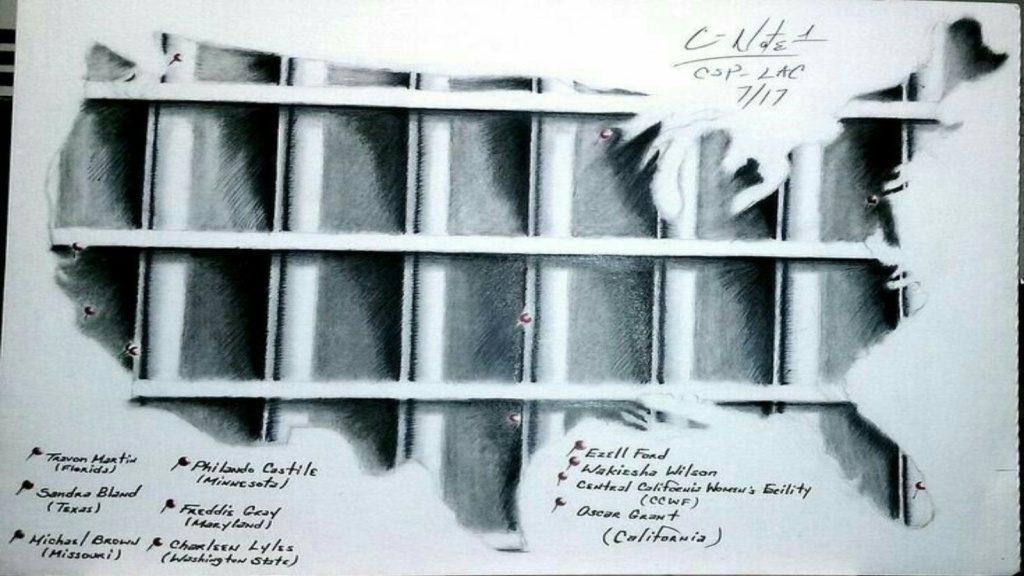During calendar year 2020 in the United States, the Coronavirus pandemic has shut down Prison Art exhibits, as well as Prison Art book promotions.
Unlike running an errand to the grocery store with a wish list, some written, some created once in the store, Prison Art exhibits are usually planned well over a year prior to the exhibition. Prisoner Art exhibits are opportunities for curators to have personal dialogues with the exhibiting public on Criminal Justice Reform. These are not feasible under Covid Public Health restrictions. As a result of covid, curators are putting their Prisoner Art exhibiting plans on hold.
In the waning days of the 2019 winter, Prison Creative Arts Project Director Nora Krinitsky was forced to announce the cancellation of its annual Prisoner Art Exhibition. The PCAP is an exhibition consisting of prisoners incarcerated throughout the state of Michigan. This year’s exhibition was going to showcase works from 26 of its 31 prisons. However, the cancellation in this calendar year was especially heartbreaking, as this year’s exhibition was its Silver Jubilee, 25 years of exhibiting Prisoner Art. During this illustrious 25 years, it has become one of the largest exhibitions by incarcerated artists in the world.
We’ve reached out to some of the curators in this space for their answers to how covid has impacted their ability to exhibit.
Prison Arts Touching Hearts (P.A.T.H.)
Prison Arts Touching Hearts was founded in 2005 by its Director, Leslie Lakes. Lakes, a professional artist, was first exposed to Prison Art while in New York City, at The Fortune Society’s, Fifth Annual Inmate Art Auction. As a result of successful bids on some of the artwork, this changed her life. It led to reaching out to these artists, and inspired her to share this hidden away art with the general public. “P.A.T.H. was formed from the heart,” states Lake. A labor of love from her long-standing desire to create a platform to showcase the incredible talent of these artists. It also provided a platform for those in the shadows, hidden from the public eye, to use art, in giving back to the community.
DRPA: Has coronavirus changed any of your 2020 exhibiting plans?
LAKES: YES!!!!!! I had worked very hard 1 to 1-1/2 years ago approaching and communicating with various art gallery venues to get exhibits of inmate artwork on their 2020 calendars, and due to Covid, ALL THREE MAJOR INMATE ART EXHIBITS WERE CANCELLED FOR THIS YEAR. Terribly frustrating and disappointing. Cannot recoup that time.
DRPA: What have you done or are planning to do in the alternative?
LAKES: PATH had scheduled and was looking forward to a major installation of art for an exhibit this Fall at a stunning venue in Tiburon, CA The title of the exhibit: “BIRDS, BEES, BUTTERFLIES AND FLOWERS” and the participating incarcerated artists had created pieces of art around this subject matter in various mediums and sizes (which they generously donated to PATH). The exhibit was a special fundraising event ; the proceeds going to the ST. JUDE CHILDREN’S RESEARCH HOSPITAL per majority vote decision on the part of the inmate artists. So, now that the exhibit will not take place as scheduled, I am starting to list the individual pieces for sale on Ebay. Ebay has a special feature where one can select a charitable non profit foundation, as well as percentage of the art sale. So, between several weeks ago and moving forward up through till the end of this year, I will continue to list the individual pieces of art that would have been on exhibit and for sale on my Ebay site. Anywhere from 50-70% of proceeds from the sale of the art will go DIRECTLY to the ST. JUDE CHILDREN’S RESEARCH HOSPITAL as was originally planned.
DRPA: Roughly how many exhibits have you done?
LAKES: Roughly 15
DRPA: Does this include the two Alcatraz Exhibitions, the one at the federal prison on Alcatraz Island in the San Francisco Bay, and the Alcatraz East Crime Museum in Pigeon Forge, Tennessee?
LAKES: Yes
DRPA: Are there any other information about you or your organization you would want reported on?
LAKES: Yes, please. If people are interested in perusing the artwork to possibly purchase on Ebay for the above mentioned art fundraising event, kindly let them know to contact me at PATH.
DRPA: Absolutely.
LAKES: Thank you!!!
[Editor’s Note]: You can buy original works of art from the Birds, Bees, Butterflies, and Flowers Exhibition on Ebay. All purchases are donated to the St. Jude Children’s Research Hospital. Here is the Ebay link: https://www.ebay.com/sch/i.html?sid=2froggiesleslie&isRefine=true&_pgn=1
Ink From The Pen
Ink From The Pen has one of the world’s largest social media followings of those who are aficionados of Prison Art. In 2014, Pamela Delgado trademarked Ink From The Pen. Later that year, she created a magazine, and presented it to her husband for his birthday. Delgado’s husband has been serving a twenty-year federal prison sentence. Although Ink From The Pen had to be kept a secret from her husband, in order to surprise him for his birthday, it now serves as a public affirmation of her commitment to their relationship during these difficult family times. Her husband Lino, aka Spanky, is also a renowned artist behind the wall. In November of 2015, Ink From The Pen held an exhibition in Sin City, at the Corner Gallery in downtown Las Vegas, Nevada. The exhibition was for November’s First Friday. First Friday features new and emerging artists every month at the Corner Gallery. The gallery’s Preview Thursday, for the Ink From The Pen exhibition, held a panel discussion on art programs inside of prisons. It featured Jose “Grumpy” Lopez, who once spent time at Pelican Bay State Prison, a super maximum security prison in California, and Sons of Anarchy actor MC Pancho. For prisoners serving time anywhere on the globe, every new release of Ink From The Pen Magazine is like Santa Claus putting a gift under the Christmas tree.
DRPA: Did INK FROM THE PEN have any events scheduled for 2020 that were cancelled due to Covid?
Delgado: I had one prison art expo in Pomona cancelled.
DRPA: Have any alternatives presented themselves?
Delgado: No other opportunities have been presented yet… to many lockdowns… and I will not do all the preparation for an event until I’m 100% sure it won’t be cancelled again.
DRPA: What inspired you to dedicate yourself as a prison art advocate?
Delgado: I began this mission and founded INK FROM THE PEN when my husband was arrested by the FBI and got his second 20 bid. He is a prison artist himself… and it is my way of showing him, and everyone else that I am still 100% by his side.
DRPA: How many prison art exhibitions have you done?
Delgado: I have done 2 expo’s that I was the sole curator, and participated in 4 others.
DRPA: Have any of the feedbacks from prisoners you have either exhibited or published been touching? If so, could you share one?
Delgado: I have lots of feedback from both the inmates and from their families as well… The most touching that is fresh in my mind is a Texas inmate that sent me several pieces of his art.. I recently found a collector to buy them and sent the money to his wife… unbeknownst to me she had lost her job due to covid, and had no way of providing any type of xmas for their children… the money that I sent made that possible for them
DRPA: Is there any other information about you or your organization you would like to inform the public of?
Delgado: The information that I really want people to know and understand is… What I do is from the heart… I do not pay the artists that are published because that is against prison policy, and they would start disallowing the magazines. The magazine itself is non-profit for just this reason. What I provide is a platform for them to get their art and their talent recognition and hopefully private collectors. It is in no way to glorify their crime… it is supposed to be giving them something positive to work on while they are behind those walls.
DRPA: Thank you very much Mrs. Delgado. This was very, very, insightful about the work you are doing.
Delgado: You’re welcome.
[Editor’s Note]: Ink From The Pen Magazine is an approved vendor for federal, state, and county correctional facilities. You can purchase current and back issues of Ink From The Pen Magazine at their website. https://inkfromthepen.com/
Escaping Time: Art from U.S. Prisons
Escaping Time: Art from U.S. Prisons is an annual art exhibition on Governors Island near downtown Manhattan in New York City, New York. The annual event’s first exhibition was in 2015. It was the result of founder Mark Thivierge, a retired Chief Financial Officer, being exposed to paños at El Museo Del Barrio in Upper Manhattan, New York City. Paños are drawings made by prisoners on handkerchiefs, predominately with an ink pen. After its first exhibition, Thivierge brought on Jay Darden as the exhibition’s lead curator. Darden, a former participating prisoner artist, brings an insider’s dialogue to visitors coming to the event.
DRPA: What is Covid-19 doing to your 2020 exhibition plans?
Darden: The Covid-19 pandemic has brought live exhibitions to a halt for us this year. Under normal circumstances, Escaping Time would be in the middle of its annual exhibition on Governors Island in NYC. However, because of safety concerns, there is no exhibition this summer.
DRPA: Are there alternative planning in the works?
Darden: We have not yet begun to even plan future exhibitions, as one of the key elements to Escaping Time is the dialogue we are able to have with visitors about both the artwork and the myriad issues related to the criminal justice system. We are still receiving artwork from people incarcerated around the United States, and we are using Instagram to highlight the artists and their work as an alternative to our live exhibitions.
DRPA: How long have you been working with prisoner artists?
Darden: Escaping Time has been exhibiting on Governors Island every summer since 2015, with the exception being this summer.
DRPA: Are you finding support for this work?
Darden: Governors Island is very supportive of the arts, and a variety of organizations and galleries use space on the island each year, with occasional collaboration.
DRPA: Thanks Jay for your assistance.
Darden: Thanks for reaching out to us at Escaping Time.
[Editor’s Note]: You can buy Art prints by Darden at DardenArt http://dardenart.com/
Honey Art Studio
In 2014 at Solano State Prison, Ericka Scott married her husband Pride, a California State prisoner. Pride, as a birthday present, commissioned a drawing of their wedding photo. When Ericka saw the drawing she fell in love with it. She knew the artist who did the drawing needed to be seen by a wider audience. Together, the Scotts began a labor of love in exposing this form of Art to a wider viewing public. Working with the Yerba Buena Center For The Arts, the Scotts were about to see their nearly half a decade labor of love become an exhibition.
DRPA: Tell us about the Beauty Behind Bars/No More Shame Exhibition.
Ericka: This is the first show Honey Art Studio is hosting and because of covid we had to cancel the indoor gallery showing. I’m very grateful for my partner Yerba Buena Center for the Arts who helped me curate the virtual gallery.
DRPA: What keeps you motivated to keep working in this social space?
Ericka: My husband and I partner on our projects, he is incarcerated (he’s been incarcerated for 21 yrs). He sent me an anniversary gift which was a drawing of a photograph during the day we were married. I was so impressed with the drawing I wanted to highlight the artist. My husband and I decided to showcase more artists. His role is to coordinate with the artists to get their work to me. Other friends and family who are housed at other facilities are now interested in organizing art for me and future projects.
DRPA: So what are some other things you are doing during covid?
Ericka: I really wanted families to get together to celebrate their loved ones art in person, but due to Covid we are adjusting and creating more virtual galleries. We are creating writing workshops for families who are justice involved as well.
DRPA: Sounds like this thing is taking on a life of its own.
Ericka: The goal of Honey Art Studios Beauty Behind Bars Project is to highlight the incredible work and creativity of people incarcerated. Due to mass confusion surrounding incarceration, I feel like Black lives have literally been stolen, but due to our resiliency as a people we are still thriving in spite of the inhumane treatment of many Black people.
DRPA: Thank you Ericka for sharing your organization, and family’s personal story.
Ericka: Your welcome.
Prison Art Book Publications
The coronavirus has also affected the publication and promotion of books related to Prison Art. In 1997, Princeton University Press published Phyllis Kornfeld’s book Cellblock Visions: Prison Art in America. Kornfeld, a graduate of the Philadelphia Museum of Art, began teaching art inside prisons in 1983. One prisoner, Donald “C-Note” Hooker, who read Kornfeld’s book had noted, “When I read that prison artists had a tendency to draw very light for fear of being criticized of making mistakes, especially since they were in prison for making mistakes, it profoundly changed the way I created, especially since I was guilty as charged.” Also in 1997, Magnolia Street Publishers published Professor David Gussak’s book Drawing Time: Art Therapy in Prisons and Other Correctional Settings. The book makes a cogent case of the benefits of art therapy inside correctional facilities to bring about transformative behavior.
Over twenty-years later, Harvard University Press published Professor Nicole R. Fleetwood’s book Marking Time: Art in the Age of Mass Incarceration. It was released during the coronavirus’s National Emergency declaration order. We reached out to Professor Fleetwood and others working to publish prison artbooks during this coronavirus pandemic.
Marking Time: Art in the Age of Mass Incarceration
DRPA: How has your book release of Prison Art been affected by the Coronavirus?
Professor Fleetwood: I appreciate your question. The book was released on April 28 to the general population but I had arranged with Harvard University Press and the Art for Justice Fund to send a paperback edition of the book to people in prison gratis by mid-March. So my first and primary readers have been imprisoned people. I started to get amazing messages and reviews of the book from prison early on. That has been more meaningful than I have words to describe.
For April and May, I had numerous in-person events scheduled. Many were group events with artists in the book and exhibit. Within a few days in mid-March, almost everything was canceled. By April some of the events were turned into virtual gatherings. Also, lots of new experiences and opportunities arose as people experimented with ways of coming together and connecting during the pandemic. Over the past five months, I have probably done more than 50 virtual events. It’s been exhilarating and exhausting. I definitely feel a stronger sense of connection and community, though I am missing in-person events.
DRPA: How long do you schedule for, before an actual book touring event?
Professor Fleetwood: I didn’t plan a book tour. I think many people who work with commercial presses do. I’ve worked with my incredible publicist at Harvard University Press and artists and organizations featured in the book to expand audiences.
DRPA: Were there any personal economic impacts?
Professor Fleetwood: As an academic, I don’t write books to make money. That’s a benefit and privilege of having a secure, tenured job. I know everyone is not in that position. As much as possible I share the experience of promoting the book with artists who appear in the study. I also share speaking fees or honoraria. This book is truly a collective project.
DRPA: Any lessons for a future author releasing a book during a pandemic?
Professor Fleetwood: As much as possible, share the book with your existing networks and share your passion for the work. Expand the project beyond yourself so that others feel invested in the work. Most importantly follow the passion and commitments that led you to the work.
DRPA: Thank you for answering our questions, and your last answer to rely on one’s own network is invaluable, thanks.
Professor Fleetwood: You’re welcome.
[Editor’s Note]: You can purchase Marking Time: Art in the Age of Mass Incarceration at Harvard University Press https://www.hup.harvard.edu/catalog.php?isbn=9780674919228
Art for Redemption
Buck Adams, a former Colorado State prisoner, witnessed firsthand the incredible artistic talent Behind Bars. An alumni of Defy Ventures, who in 2015 began an entrepreneur mentorship program inside U.S. prisons, Adams merged his entrepreneurial spirit with his passion for prison art to create Art for Redemption, an Etsy for prison art. In February of 2020, Art for Redemption announced $100,000 of seed funding from Rockies Venture Club and Rockies Impact Fund. Working with Defy Colorado, and other organizations, invitations were sent out to prisoners to submit artwork for inclusion in a coffee table book. Proceeds from the book would be used for the website’s technical engineering. The website will provide prisoners with the opportunity to sell their artwork with 60% of the proceeds going to prisoners. This extra cash will allow prisoners to meet some of their financial obligations, such as child support, and fees or fines associated with their convictions. Adams upon his reentry, experienced firsthand, conviction related debt obligations, and saw Art for Redemption as a means to lessen these reentry debt burdens. These reentry court ordered financial obligations are very serious. In 2018, voters in Florida voted to restore the voting rights of ex-prisoners. However, Florida legislatures passed a law barring this right if the prisoner still owes fees or fines associated with their convictions. This law has been upheld in court.
DRPA: Has coronavirus changed any of your 2020 Prisoner Art plans?
Adams: Yes – significantly so. It has probably moved my timeline at least a year.
DRPA: What have you done or are planning to do in the alternative?
Adams: We just went into cruise control with social media posts. Outside of that, all plans were put on hold.
DRPA: How long have you been working with prison artists?
Adams: While incarcerated I worked with guys on portraits and other drawings for my own personal use. I also had multiple artists doing greeting cards for me. Since being out and starting this project about a year ago… COVID hit right while we were starting to gear up on plans.
DRPA: What was it about Prison Art that made you get interested in it?
Adams: My time being incarcerated.
DRPA: Are there any other information about you or your organization you would want reported on?
Adams: The coffee table book is really a means to the ends of promoting prison reform and getting the sales platform up and going. Participating in the book is a way to help not only promote the platform but also potentially help other prison systems open up to the idea that inmates making money to help pay their socialtial debts, take some of the financial burden off of their families through the use of creativity and art should be something looked at as positive. Doing the time is the punishment. To not allow one to share creativity and talent is beyond the scope of punishment I believe.
DRPA: Thank you for participating Buck.
Adams: You’re welcome.
Cellblock Visions: Prison Art in America
DRPA: After Cellblock Visions was released, did it change your life in any way?
Kornfeld: The only major change in my life from the book being published is that it gives me the credentials I need to arrange lectures and exhibitions. I want to get the word out to many many people. Especially students.
DRPA: Were there any lectures affected by Covid-19?
Kornfeld: I did have a show booked at St. Lawrence University plus some slide talks and workshops at other university venues. Hopefully they will be rescheduled. Of course most all in-person exhibitions on many topics and around the world have had to deal with cancellations.
I began doing this work in 1983 in several Oklahoma prisons, men and women, for 6 years before I moved to Massachusetts. I put a show together that first year because I immediately saw the value in the work and the beauty and I thought wow, everybody has to see this!!!
I’m waiting for Covid to go away so I can continue my work at the local jail. Been there for 25 years.
DRPA: Do you have any stories from prisoners on how your book impacted them?
Kornfeld: Almost all of the artists in the book were not in the same state that I was in when the book was finally published. Many of the artists in prisons learn from each other how to do portraits for one thing. They often do beautiful work. The people who come to my classes are mostly completely inexperienced and just have a feeling that maybe they would like it. The main thing I teach is not any technique but rather a direct connection with a natural human place inside that is deeper than feelings and life experiences (but may include them). Once that’s tapped into, artists continue to create new and surprising imagery.
Once released, this creative power is self-generating, book or no book, admiration or not, really it’s art for art’s sake. I teach that good art is an act of generosity. It isn’t just about you.
We go by this quote from Piet Mondrian:
“The position of the artist is humble. He/she is essentially a channel.”
DRPA: Thank you so much Phyllis
Kornfeld: Keep up the good work you are doing DaReal.
[Editor’s Note]: You can purchase Cellblock Visions: Prison Art in America from Princeton University Press https://catalog.princeton.edu/catalog/1123520
DAREALPRISONART
Is a seller of Prison Art prints, and a publisher of the drawings, writings, sound recordings, and videos, by prisoners. We also publish news reports surrounding the politics of prison. To learn more https://darealprisonart.wordpress.com/about
Top image: Incarceration Nation | Wikimedia Commons
This post was originally published on this site be sure to check out more of their content.








